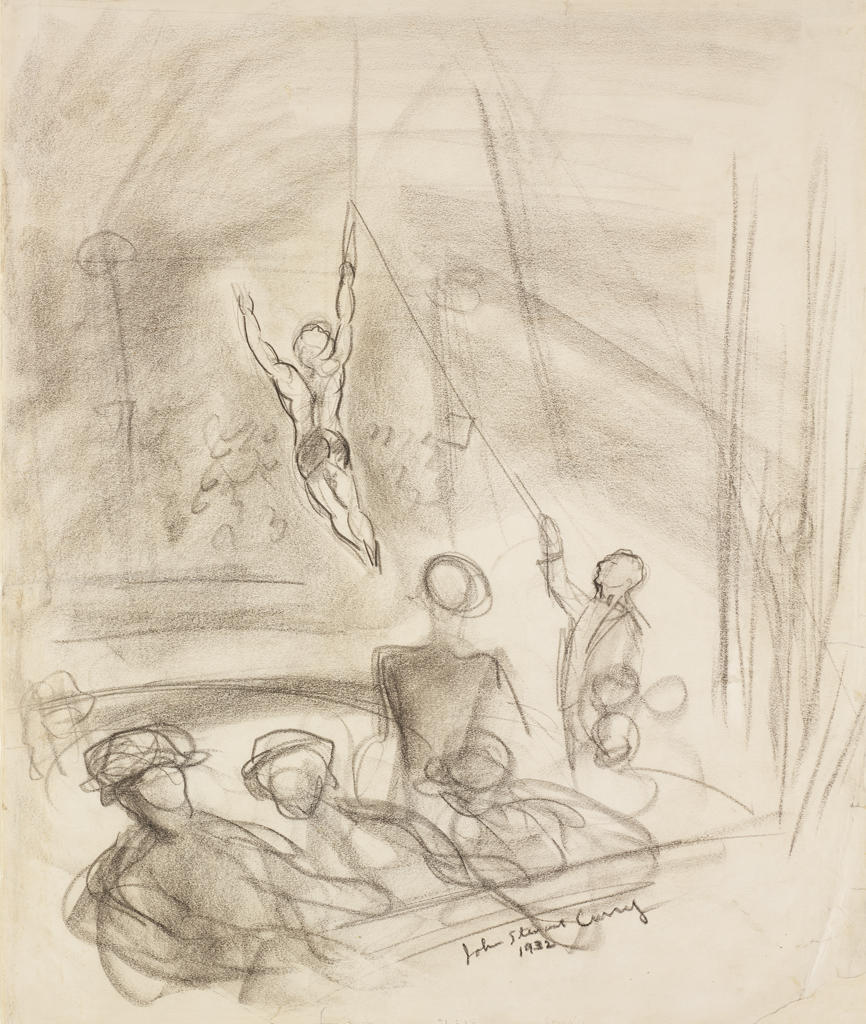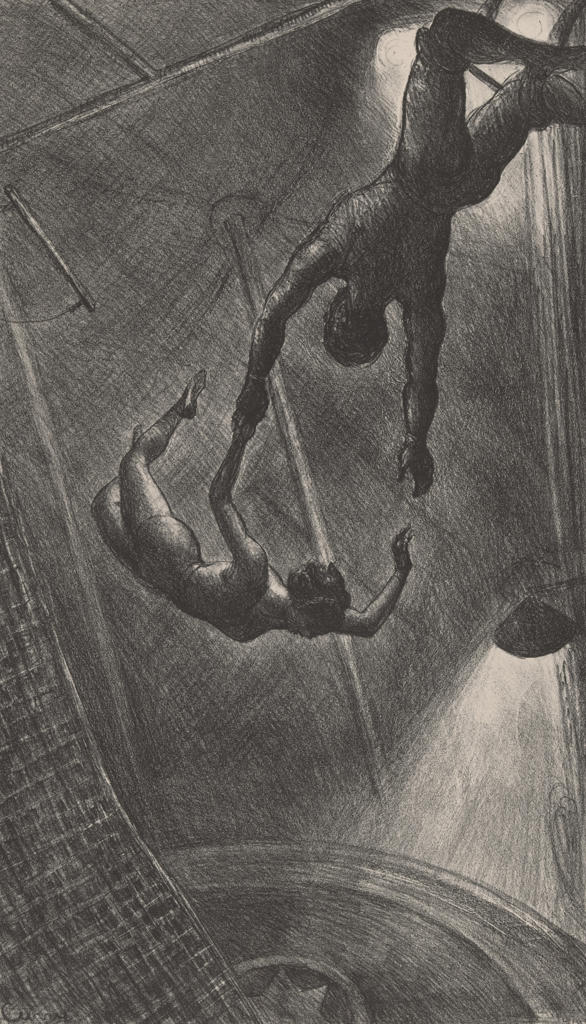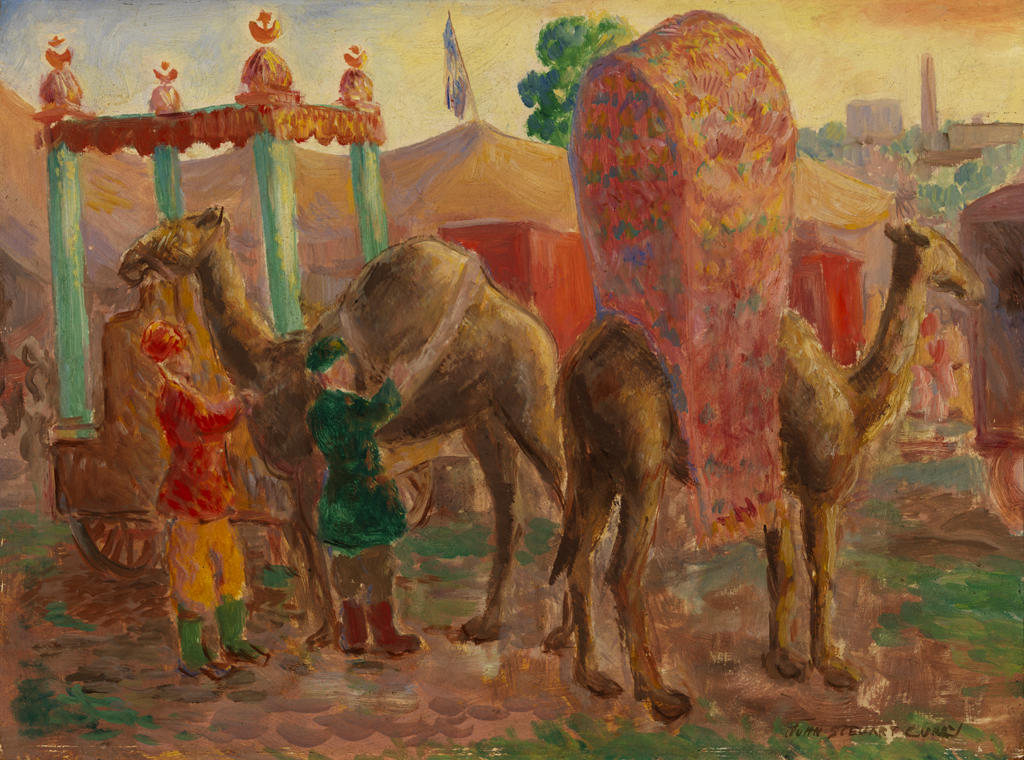Frustrated by economic troubles caused by the Great Depression and his crumbling marriage, the American artist John Steuart Curry (1897–1946) sought “a new viewpoint of life,” spending three months in 1932 traveling with the Ringling Bros. and Barnum & Bailey Circus1 . Curry joined the circus as it embarked upon its spring tour, stopping in Connecticut, New York, New Jersey, Pennsylvania, and Maryland. Curry’s three circus-themed works in the collection of the RISD Museum all present the circus from unexpected vantage points, often as a result of his direct engagement with his subjects.
Curry was particularly taken by the strength and bravery of the aerialists, and executed numerous sketches of the trapeze acts in rehearsal and performance. Tamara Codona on the Trapeze (Ringling Bros. and Barnum & Bailey Circus) (1932), was likely one of the hundreds of drawings that Curry produced during his tenure with the circus. In this drawing, European aerialist Tamara is hoisted up to the high-wire as figures in the audience lean forward in nervous anticipation. She had joined the Flying Codonas, a group of trapeze artists who were stars of the circus world, in 1931. Tamara’s act was particularly dangerous because she performed without a net. Curry described her ascent to the wire as a significant part of the spectacle: “I was impressed by the dramatic effect of this flaming beauty ascending heavenward in the brilliant spotlight, while the wretched-looking laborers in the shadows, like ancient slaves, heaved at the ropes to raise her.”2
The artist’s interest in trapeze performers continued after he returned home, adapting many sketches drawn on site at the circus into finished paintings and prints. One such example is Missed Leap (1934), a lithograph in the RISD Museum’s collection that depicts the danger to which high-wire performers are subjected. Curry places the viewer at an unusual vantage point—up among the rigging, rather than seated in the stands—thus providing a close-up view of the aerialists in action. The disorienting angle puts the viewer in the performer’s shoes, heightening the perilousness of the scene.
The third of Curry’s circus works in the Museum’s collection is a small and vibrantly colored painting entitled Circus Camels. Completed in 1932, the painting was either executed shortly after Curry’s return home or from life, while the artist was on tour. Its diminutive size, subject matter, and broad, sketchy brushstrokes point to the distinct possibility of the latter. Circus Camels presents behind-the-scenes preparation; two handlers outfit a camel in its performance costume while another camel stands nearby wearing a howdah, a carriage often used in the Middle East and India. Considered a symbol of wealth for the owner, the howdah was often ornately decorated with jewels and luxurious fabrics. It is likely that these camels are being prepared for an Orientalist spectacle, as their handlers are costumed in vaguely Middle Eastern headgear.
Traditionally, the opening act at the circus was the spectacle, or the “spec.” Designed to transition the audience between the real world and the fantasy world of the circus, the spec became increasingly lavish in the late 19th and early 20th century, as the circus grew in size and popularity. Specs ranged in subject matter from historical re-creations, such as Columbus’s discovery of the New World, to grand processions, many of which were set in a fantasy version of the Middle East. Rather than painting a lavish scene of the camels in performance, Curry chose to depict the preparation of the animals, an everyday moment that provides the viewer a glimpse of the circus through an insider’s eyes.
Tamara Codona on the Trapeze (Ringling Brothers Barnum and Bailey Circus) (1932) and Missed Leap (1934) are included in the exhibitionCircus, on view at the RISD Museum until February 22, 2015.
Alison W. Chang, curator of the RISD Museum exhibition Circus, served as the Andrew W. Mellon Curatorial Fellow in the Department of Prints, Drawings, and Photographs from 2012 until 2015.


